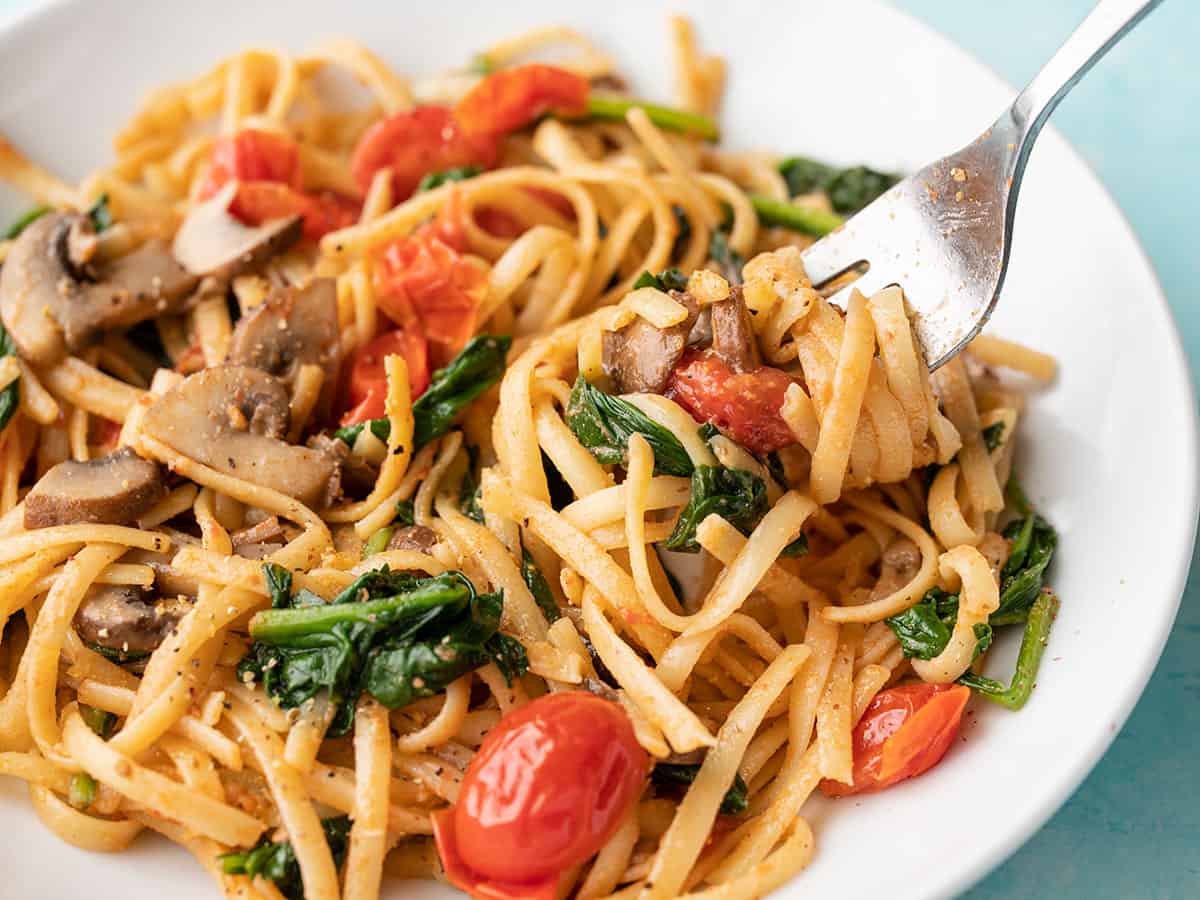Prepare to be amazed! This isn’t your grandma’s vegetarian pasta. We’re diving headfirst into a culinary adventure where vibrant vegetables, earthy mushrooms, and surprisingly satisfying textures combine to create pasta dishes that not only rival but surpass the richness and depth of their meat-laden counterparts. Forget bland and boring; get ready for explosions of flavor, satisfying heartiness, and a whole new appreciation for the versatility of plant-based ingredients. We’ll unlock the secrets to building layers of flavor, achieving perfect textures, and mastering the art of visually stunning plating – transforming simple pasta into a truly unforgettable experience.
Through detailed recipes, insightful comparisons of flavor profiles and textures, and a step-by-step guide to creating a signature dish, you’ll learn to craft vegetarian pasta that’s not just a meat alternative, but a culinary masterpiece in its own right. Imagine the rich, umami depth of roasted mushrooms mirroring the savoriness of bacon, or the satisfying chew of lentils providing a hearty protein boost. This guide will equip you with the knowledge and techniques to create pasta dishes that will leave even the most devoted carnivores craving more.
Flavor Profiles
Elevating vegetarian pasta to a level surpassing its meat-based counterparts hinges on crafting rich and complex flavor profiles. This involves understanding how to harness the inherent umami and savory notes present in various vegetarian ingredients, skillfully layering them to create a symphony of taste. The key is to think beyond simple additions and to strategically combine ingredients to achieve depth and complexity.
Umami and Savory Ingredient Comparison
The following table illustrates how different vegetarian ingredients can contribute umami and savory characteristics, mimicking the richness often associated with meat. These ingredients, when used strategically, can transform a simple pasta dish into a culinary masterpiece.
| Ingredient | Umami Contribution | Savory Contribution | Application in Pasta |
|---|---|---|---|
| Mushrooms (e.g., shiitake, portobello) | High; glutamic acid content | Earthy, rich | Sautéed, roasted, or added to creamy sauces |
| Roasted Vegetables (e.g., eggplant, bell peppers, zucchini) | Moderate; intensified by roasting | Sweet, smoky, concentrated flavors | Pureed into sauce, added as chunks, or used as a topping |
| Artichoke Hearts | Moderate; subtle umami | Slightly tangy, herbaceous | Marinated, added whole or chopped, or incorporated into pesto |
| Nutritional Yeast | High; cheesy flavor profile | Nutty, savory | Sprinkled over pasta, added to sauces for a cheesy depth |
Layered Flavor Vegetarian Pasta Recipe
This recipe demonstrates how multiple flavor layers can create a deeply satisfying vegetarian pasta dish. The combination of roasted vegetables, a vibrant herb sauce, and a sprinkle of nutritional yeast creates a complex and delicious experience.
Roasted Vegetable Medley
Preheat oven to 400°F (200°C). Toss 1 large eggplant (cubed), 2 bell peppers (1 red, 1 yellow, chopped), 1 zucchini (cubed), and 1 red onion (wedged) with 2 tablespoons olive oil, salt, pepper, and dried oregano. Roast for 25-30 minutes, until tender and slightly caramelized. The roasting process intensifies the natural sweetness and creates a depth of flavor. The vibrant colors of the vegetables also add a visual appeal to the dish.
Flavorful Herb Sauce
While the vegetables roast, prepare the sauce. Sauté 2 cloves garlic (minced) in 1 tablespoon olive oil until fragrant. Add 1 cup vegetable broth, 1/4 cup chopped fresh basil, 2 tablespoons chopped fresh parsley, 1 tablespoon chopped fresh thyme, and a pinch of red pepper flakes. Simmer for 10 minutes to allow the flavors to meld. The herbs provide a bright, fresh counterpoint to the richness of the roasted vegetables. The red pepper flakes add a subtle warmth.
Pasta Assembly
Cook 1 pound of your favorite pasta according to package directions. Reserve about 1/2 cup of pasta water before draining. Add the roasted vegetables and the herb sauce to the cooked pasta. Toss to combine. If the sauce is too thick, add a little pasta water to adjust the consistency. Stir in 2 tablespoons of nutritional yeast for a cheesy, nutty finish. The reserved pasta water helps to create a creamy consistency and binds the ingredients together.
Creating a Flavorful Vegetarian Pasta Sauce
The foundation of any exceptional vegetarian pasta dish lies in its sauce. This section details the creation of a flavorful vegetarian pasta sauce, emphasizing the importance of combining herbs, spices, and vegetables for a balanced and complex taste. A well-made sauce can transform simple pasta into a truly memorable meal. The use of fresh herbs is key to achieving a bright and vibrant flavor profile.
The process begins with a flavorful base, often sautéed garlic and onions. This forms the foundation upon which other flavors are built. Adding vegetables such as finely chopped carrots, celery, or mushrooms provides depth and complexity. The choice of vegetables is flexible and depends on personal preferences. The herbs should be added towards the end of the cooking process to retain their bright, fresh flavor. Spices can be used to add warmth, depth, and complexity, complementing the other ingredients. Examples include red pepper flakes for a touch of heat, or smoked paprika for a smoky note. Finally, a splash of wine or vegetable broth adds moisture and richness. The sauce should be simmered gently to allow the flavors to fully develop and meld together, resulting in a harmonious and delicious sauce.
Texture and Substance

A truly satisfying vegetarian pasta dish hinges on achieving a delightful interplay of textures. It’s not just about the smooth sauce coating the pasta; it’s about the satisfying chew of the pasta itself, the contrasting textures of the added vegetables, and the substantial heft provided by the chosen protein source. Mastering these textures elevates a simple pasta dish to a memorable culinary experience.
The secret to a hearty, non-mushy vegetarian pasta lies in understanding how different protein sources behave when cooked and how to best integrate them. Lentils, for example, offer a firm, earthy texture when cooked al dente, while chickpeas provide a satisfyingly creamy, almost meaty quality when roasted or well-seasoned. Tofu, on the other hand, can be incredibly versatile, taking on the flavors of its surroundings and offering a soft, yielding texture when pan-fried or a firmer, chewier bite when pressed and baked. The key is to choose a protein that complements the other ingredients and contributes positively to the overall textural experience.
Preparing a Hearty Vegetarian Pasta Dish
This recipe demonstrates how to create a pasta dish with substantial texture, avoiding the pitfalls of mushiness or watery consistency. We’ll use lentils for their hearty texture and vibrant flavor.
First, prepare your lentils. Rinse one cup of brown or green lentils under cold water. In a medium saucepan, combine the lentils with four cups of vegetable broth. Bring to a boil, then reduce heat to low, cover, and simmer for 20-25 minutes, or until the lentils are tender but still hold their shape. Avoid overcooking, which leads to mushiness. While the lentils simmer, prepare your other ingredients. Sauté a diced onion and two cloves of minced garlic in olive oil until softened. Add a cup of chopped mushrooms and a diced red bell pepper, cooking until tender-crisp. Season generously with salt, pepper, and Italian herbs.
Next, cook your pasta. We’ll use penne pasta for its ability to hold sauce and its robust shape. Cook according to package directions until al dente. Reserve about ½ cup of pasta water before draining. This water is crucial for creating a creamy sauce.
In a large bowl, combine the cooked lentils, sautéed vegetables, and drained pasta. Add ½ cup of your reserved pasta water, along with a ¼ cup of grated Parmesan cheese (or nutritional yeast for a vegan option) and a generous drizzle of olive oil. Toss everything together until well combined. The pasta water helps create a light, creamy sauce that coats the pasta and prevents dryness. Taste and adjust seasoning as needed.
Finally, serve immediately, garnished with fresh basil or parsley for a pop of color and fresh flavor. The finished dish should be vibrant, fragrant, and brimming with contrasting textures: the firm lentils, the tender vegetables, the al dente pasta, and the creamy sauce.
Cooking Methods and Pasta Shapes
The choice of pasta shape significantly impacts the final texture of the dish. Short, tubular shapes like penne or rigatoni are ideal for holding onto sauces and adding a hearty texture to the meal. Their ridges provide extra surface area for the sauce to cling to, preventing a dry or watery result. Longer pasta shapes like spaghetti or linguine, while elegant, can sometimes become mushy if overcooked or not properly coated in sauce. Thicker pasta shapes like bucatini or mafaldine tend to hold their shape better and offer a more substantial mouthfeel. Choosing the right shape is a key element in creating a texturally satisfying vegetarian pasta dish. Overcooking any pasta shape will result in a mushy texture, so always follow package directions and cook until al dente.
Step-by-Step Guide
This recipe guides you through the creation of a vibrant, flavorful vegetarian pasta dish featuring roasted butternut squash, sage, and creamy parmesan sauce. The result is a visually stunning and incredibly satisfying meal that surpasses even the most hearty meat-based pasta. Each step is designed to maximize flavor and texture, resulting in a truly memorable culinary experience.
Roasted Butternut Squash Preparation
Begin by preheating your oven to 400°F (200°C). This ensures the squash roasts to perfection, developing a deep, caramelized sweetness. Cut a medium butternut squash in half lengthwise, scoop out the seeds, and then slice into roughly 1-inch thick half-moons. Toss the squash pieces with 2 tablespoons of olive oil, a generous pinch of salt, and freshly ground black pepper. Spread them in a single layer on a baking sheet. Roast for 25-30 minutes, or until tender and slightly browned at the edges. The roasting process intensifies the natural sweetness of the squash, creating a delightful contrast to the savory sage and creamy parmesan.
Sage Brown Butter Sauce
While the squash is roasting, prepare the sauce. Melt 4 tablespoons of butter in a medium saucepan over medium heat. Continue cooking, swirling the pan occasionally, until the butter turns a light golden brown and emits a nutty aroma. This process, known as browning the butter, adds a complex depth of flavor to the sauce. Remove the pan from the heat immediately to prevent burning. Stir in 1/4 cup of finely chopped fresh sage. The sage’s earthy aroma complements the sweetness of the squash and the richness of the brown butter beautifully.
Pasta Cooking and Assembly
Cook 1 pound of your favorite pasta according to package directions. We recommend using a pasta shape that holds sauce well, such as penne, rigatoni, or farfalle. Once cooked, reserve about 1/2 cup of pasta water before draining. Add the cooked pasta to the saucepan with the sage brown butter. Stir in the roasted butternut squash and 1/2 cup of grated Parmesan cheese. Slowly add the reserved pasta water, a tablespoon at a time, until you achieve your desired consistency. The pasta water helps create a luscious, creamy sauce that coats each strand of pasta perfectly.
Final Touches and Visual Presentation
Finish the dish with a final flourish of freshly grated Parmesan cheese, a sprinkle of cracked black pepper, and a few extra sage leaves for garnish. The final dish is a symphony of colors and textures. Imagine a vibrant mix of golden-brown roasted butternut squash pieces nestled amongst swirls of creamy, sage-infused brown butter sauce, clinging to perfectly cooked pasta. The contrasting colors and textures create a visually appealing masterpiece. The glistening sauce adds a touch of elegance, while the scattered sage leaves provide a pop of fresh green.
Tips and Tricks for Optimal Results
Proper cooking times are crucial for achieving optimal results. Undercooked squash will be hard and lack sweetness, while overcooked squash will become mushy. Similarly, don’t overcook the butter while making the brown butter sauce, as this will lead to a burnt flavor. Feel free to substitute other winter squashes, such as kabocha or delicata, for the butternut squash. For a vegan option, replace the Parmesan cheese with nutritional yeast for a similar cheesy flavor. Experiment with different herbs, such as thyme or rosemary, to create your own unique variations. Adding a pinch of red pepper flakes can introduce a pleasant level of spiciness.
From mastering the art of building complex flavor profiles to achieving the perfect texture and creating visually stunning plates, this journey into vegetarian pasta has revealed the immense potential of plant-based ingredients. No longer a mere side dish, vegetarian pasta, when approached with creativity and skill, transforms into a culinary star, showcasing the incredible depth and versatility of vegetables, legumes, and herbs. The recipes and techniques presented here are not just instructions; they’re invitations to experiment, to innovate, and to redefine your expectations of what vegetarian pasta can be. So, embrace the challenge, unleash your inner chef, and prepare to create pasta dishes that are not only delicious but truly unforgettable.
FAQ Compilation
Can I use frozen vegetables in these recipes?
Yes, frozen vegetables work well, but ensure they are thoroughly thawed and drained before adding them to prevent excess moisture.
What kind of pasta is best for these recipes?
Choose a pasta shape that complements the sauce and ingredients. For thicker sauces, shorter pasta like penne or rigatoni works well. For lighter sauces, long pasta like spaghetti or linguine is ideal.
How can I make these recipes gluten-free?
Use gluten-free pasta and ensure all other ingredients are gluten-free. Many gluten-free pasta options are available.
How long can I store leftover vegetarian pasta?
Store leftover pasta in an airtight container in the refrigerator for up to 3-4 days.


